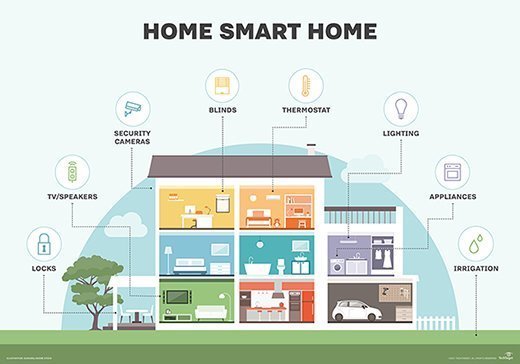News
What is a smart home?
What is a smart home?
A smart home is a residence that uses internet-connected devices to enable the remote monitoring and management of appliances and systems, such as lighting and heating.
Smart home technology -- also often referred to as home automation or domotics from the Latin word domus, meaning home -- provides homeowners security, comfort, convenience and energy efficiency by letting them control smart devices, often using a smart home app on their smartphone or another networked device.
A part of the internet of things (IoT), smart home systems and devices often operate together, sharing consumer usage data among themselves and automating actions based on the homeowners' preferences.
How does smart home technology work?
A smart home isn't a collection of disparate smart devices and appliances, but rather ones that work together to create a remotely controllable network.
All devices -- such as lights, thermostats, security systems and appliances -- are controlled by a master home automation controller, often called a smart home hub. This hub is a hardware device that acts as the central point of the smart home system and can sense, process data and communicate wirelessly. It combines all the disparate apps into a single smart home app that homeowners can control remotely. Examples of smart home hubs include Amazon Echo, Google Home and Wink Hub. While many smart home products use Wi-Fi and Bluetooth to connect to the smart home network, others depend on wireless protocols such as Zigbee or Z-Wave.
Smart home devices can be either programmed to follow specific schedules or commands or they can be set to respond to voice commands through home assistants such as Amazon Alexa or Google Assistant. For example, a smart thermostat can learn the homeowner's habits and automatically adjust the temperature based on their specific schedule.
Examples of smart home technologies
Nearly every aspect of life where technology has entered the domestic space -- including lightbulbs, dishwashers and other appliances -- has seen the introduction of a smart home alternative:
Smart TVs. These TVs connect to the internet to access content through applications, such as on-demand video and music. Some smart TVs also include voice or gesture recognition.
Smart lighting systems. In addition to being able to be controlled remotely and customized, smart lighting systems can detect when occupants are in the room and adjust lighting as needed. Smart lightbulbs can also regulate themselves based on daylight availability.
Smart thermostats. Smart thermostats, such as Google Nest, come with integrated Wi-Fi, letting users schedule, monitor and remotely control home temperatures. These devices also learn homeowners' behaviors and automatically modify settings to provide them with maximum comfort and efficiency. Smart thermostats can also report energy use and remind users to change filters.
Smart door locks and garage door openers. Homeowners can use smart locks and garage-door openers to grant or deny access to visitors. Smart locks can also detect when residents are near and unlock the doors for them.
Smart security cameras and systems. With smart security cameras and doorbells, such as Ring, residents can monitor their homes when they're away. Smart motion sensors can identify the difference between residents, visitors, pets and burglars and can send notifications to authorities if suspicious behavior is detected.
Smart pet and lawn care. Pet care can be automated with connected feeders. Houseplants and lawns can be watered using connected timers.
Smart kitchen appliances. Brands such as LG, GE and Samsung offer smart kitchen appliances of all sorts. These appliances include smart coffee makers that can brew a fresh cup automatically at a programmed time; smart refrigerators that keep track of expiration dates, make shopping lists or even create recipes based on ingredients currently on hand; slow cookers and toasters; and, in the laundry room, washing machines and dryers.
Smart household monitors. Household system monitors can, for example, sense a power surge and turn off appliances, sense water failures or freezing pipes and turn off the water so the home doesn't flood.
Smart plugs. These connect to wall sockets to transform simple home devices, such as lamps and ceiling fans, so they can be controlled remotely via mobile apps and voice assistants such as Alexa.

How to set up a smart home
Newly built homes are often constructed with smart home infrastructure in place. Older homes, on the other hand, can be retrofitted with smart technologies.
Zigbee and Z-Wave are two of the most common home automation communications protocols in use today. Both use mesh network technologies and short-range, low-power radio signals to connect smart home systems. Though both target the same smart home applications, Z-Wave has a range of 30 meters versus Zigbee's 10 meters, with Zigbee often perceived as the more complex of the two. Zigbee chips are available from multiple companies, while Z-Wave chips are only available from Sigma Designs. Also, Matter -- the newest smart home standard that was launched in November 2022 -- is gaining momentum. Developed by the Connectivity Standards Alliance -- previously the Zigbee Alliance -- Matter is supported by major smart home manufacturers including Amazon, Apple and Google. This IP-based protocol is specifically designed to solve the compatibility challenges of smart homes, providing a framework that facilitates seamless communication across devices, apps and cloud services.
Some smart home systems can be created from scratch, for example, using a Raspberry Pi or other prototyping board. Other systems can be purchased as a bundled smart home kit -- also known as a smart home platform -- that contains the pieces needed to start a home automation project.
While setting up a smart home can sometimes be complex, homeowners should consider the following general steps:
Invest in a strong, reliable internet connection. Because smart home connectivity relies heavily on an internet connection, it's important to ensure the homeowner has reliable and fast internet service.
Select the hub. It's important to decide which hub to use for a smart home. For example, if the homeowner wants a fully automated smart home, a hub that can centrally control every device is most likely required. However, in other cases, a virtual assistant that can link to other devices on the same network could suffice. Most average hubs might not include extra capabilities such as built-in voice control, even if they're compatible with a wide range of devices. On the other hand, smart speaker hubs, such as Amazon Echo, let users provide voice commands and accomplish various tasks, such as inquiring about the weather or requesting a grocery list.
Start with the basics. Start with basic items such as smart plugs, smart bulbs and switches for the smart home, as they're quick to set up and can easily automate many different things around the house. For example, smart plugs can automate fans, lights, lamps, slow cookers, curling irons and space heaters.
Secure the devices. Because most IoT and smart home devices don't have in-built security or encryption, it's important to set up strong passwords and multifactor authentication to prevent unauthorized access to these devices.
Add more devices. As the homeowner becomes more comfortable with creating a smart home, they can add more devices, such as security systems, cameras and video doorbells, to the mix.
In simple smart home scenarios, events can be timed or triggered. Timed events are based on a clock, for example, lowering the blinds at 6 p.m., while triggered events depend on actions in the automated system; for example, when the owner's smartphone approaches the door, the smart lock unlocks and the smart lights go on.
Machine learning and artificial intelligence are becoming increasingly popular in smart home systems, enabling home automation applications to adapt to their environments. For example, voice-activated systems, such as Amazon Echo or Google Home, contain virtual assistants that learn and personalize the smart home to the residents' preferences and patterns.
Future developments in smart device technology will combine language models and virtual assistants, such as ChatGPT. Some companies are already using this technology to build their own personal assistants, while Amazon is currently working on a significant language model called large language model to improve Alexa.



